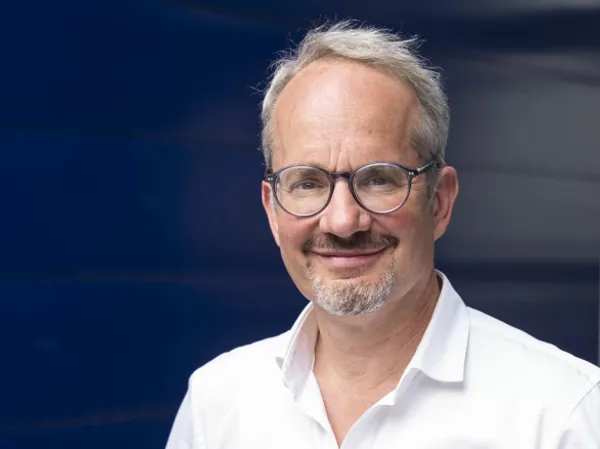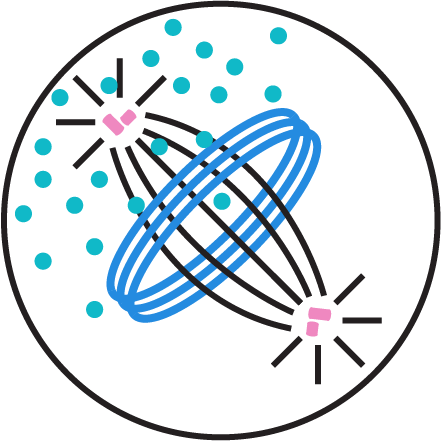People

Tony Hyman
Dr. Anthony A. Hyman has made significant contributions to molecular and cell biology, particularly in understanding the mechanisms of cell division and cell compartmentalization. Perhaps his two most notable achievements include utilizing RNA interference to map various cytoplasmic processes and discovering that compartments in cells can form via phase separation. His expansive body of work has also illuminated fundamental interworkings of protein complexes and cellular structures like the mitotic spindle, centrioles, and P granules. Currently his research is aimed at exploring how phase separation of intrinsically disordered proteins may drive neurodegenerative diseases including ALS.
Laboratory of Molecular Biology: Cambridge, UK
Hyman began his career as a student at the LMB in Cambridge, in Sydney Brenner’s C.elegans group, under the supervision of John White. There, he studied the orientation of the cell division axes during the early cell divisions of C.elegans embryos using microscopy and microsurgery, which he published in two papers in the Journal of Cell Biology (Hyman and White 1984; Hyman 1986). At the two-cell stage, the cleavage axes in this organism are stereotyped, with one cell (AB) undergoing an equal cleavage on the expected axis, and the other (P) cleaving unequally on an orthogonal axis, thus creating a germ line lineage of smaller cells at the posterior pole. It was known that the mitotic spindle rotates in P prior to cleavage, as in other cases of unequal cleavage, but nothing was known as to the mechanism of rotation. Using a laser beam to cut microtubules, Hyman showed that pulling forces acting from the posterior cortex on microtubules drives spindle rotation. University of California San Francisco: San Francisco, CA
Hyman next pursued post-doctoral research in the laboratory of Tim Mitchison at the University of San Francisco CA. There, he probed the interaction between microtubules and chromosomes that give rise to the mitotic forces that segregate chromosomes. He set up real-time microscopy assays to study this interface that discovered the presence of motor proteins at kinetochores in both mammalian and yeast systems, described in two papers (Hyman and Mitchison 1991; Hyman et al 1992). During his post doc, Hyman made and characterized a number of important tools for studying microtubule dynamics that are still in constant use, including the untypical non-hydrolyzeable GTP analog GMPCPP, various fluorescent tubulin derivatives, and assays for motors and microtubule polarity.
European Molecular Biology Laboratory: Heidelberg, Germany
Hyman established his first independent group at the EMBL in Heidelberg. Initially, he worked closely with Dr Eric Karsenti. Their shared work had a major influence on our current understanding of how a meiotic spindle can self-assemble, and by extension, illuminated principles for self organization of cytoplasm more generally. The dominant hypothesis for how spindles assembled at that time was dominated by centrosome nucleation, microtubule search by dynamic instability, and capture by kinetochores. Hyman, Karsenti, Heald and co-workers showed that in egg meiotic spindles, nucleation occurs around chromosomes, and then the spindle self-organized using motor proteins as well as local modulation of microtubule dynamics. This work was published in a series of papers from 1996-2000 (Heald et al 1996; Heald et al 1997). Hyman was particularly interested in regulators of microtubule polymerization dynamics, and his group discovered that the key factors in Xenopus egg extracts, were the opposed activities of a stabilizing protein, XMAP215 and a destabilizing protein, XKCM1 (a kinesin family member). Key questions in the microtubule dynamics arena include the structural basis of dynamics instability, and how these dynamics are regulated by protein factors. Hyman addressed the first question using cryo-em, publishing a significant paper that showed how GTP hydrolysis destabilizes microtubules by causing protofilaments to curl up, thus unpeeling the lattice like a banana skin (Mueller al 1998), and he has recently confirmed this work using atomic force microscopy in collaboration with the lab of Daniel Mueller. (Elie-Caille et al). He has worked on the second question in several ways. In 2001 he published a paper reconstituting fast dynamic instability with pure proteins for the first time, using the factors he had previously identified in Xenopus extracts (Kinoshita et al 2001). In his recent genomic work, he has made an exhaustive list of the factors that regulate dynamics, and is pursuing key players to the level of molecular mechanism.
Max Planck Institute of Molecular Cell Biology and Genetics: Dresden, Germany
After his move to Dresden, Hyman’s main line of research is the molecular and biophysics basis of cytoplasmic organization during C elegans early development. 30 minutes after fertilization, a relatively undifferentiated occyte organizes into an asymmetric cytoplasm that divides into two cells with different developmental fates. His lab has worked on various aspects of this problem: Cortical polarization, spindle formation and microtubule dynamics.
Formation of cortical polarity
Polarity formation depends on the formation of a differentiated cortex. How does a cortex differentiate into two different domains? Hyman worked on two aspects of cortical differentiation, formation of PAR domains and the positioning of the cytokinesis furrow. He worked on the role of small GTPases in symmetry breaking (schoenegg et al), and Hyman’s group also identified the centrosome as the source of the signal that breaks polarity as the 1-cell embryo polarizes, and this signal appears to not depend on microtubules (Cowan et al 2004). In a 2005 paper, (Bringmann and Hyman) discovered that both asters and spindle midzones send parallel signals to the cortex to induce cleavage furrows. Normally these signals overlap in time and space, but laser surgery allowed them to be separated for analysis. This paper resolves a long-standing controversy in cytokinesis mechanism, and sets the stage for molecular dissection of two parallel pathways in cytokinesis.
Spindle positioning in C.elegans
How is a spindle properly positioned within a cell? Positioning is downstream of the polarity machinery. Hyman established a collaboration with Joe Howard, using laser microsurgery to create abnormal distribution of forces in the cytoplasm, and inferring the distribution of forces from the ensuing behavior. Three papers published using this method described the forces acting on microtubules at the cortex in detail, fragmenting centrosomes, and then analyzing the variance in the velocity of fragment movement between embryos to infer the number and distribution of force producing elements. This study borrowed ideas from classic work on ion channels that had not before been used to study the cytoskeleton (Grill et al 2001;2003).
P granule formation
The Hyman lab has also worked on how another downstream polarity event, the formation of P granules (Brangwynne et al 2009). These granules segregate with the germ-line, and their formation is dependent on establishment of cell polarity. They consist of protein and RNA, and in different forms they are ubiquitous in the animal kingdom. This work showed that P granules have surprising liquid-like properties, with features rather like colloidal liquids. RNAs and proteins have multiple weak interactions that are suitable for such liquid-like behaviour. These liquid-like properties allow them to assemble and disassemble rapidly and P granule assembly can be modeled as a phase transition, between a dispersed and a liquid state, which is under control of the polarity machinery. An analogy would be the formation of condensed water droplets from liquid vapor during cooling, in which temperature rather than polarity controls the phase transition. The concept of a phase transition would allow rapid formation of reaction centers and could also represent an early stage in patterning of life.
Parts lists-defining the components in C.elegans
The Hyman lab’s second line of research in the C. elegans embryo involves use of functional genomics to identify “parts lists” for different cytoplasmic processes, then use of detailed microscopy and genetic perturbation to understand pathways underlying various processes. In two papers (Gonczy et al 2000; Soennichsen et al 2005), the Hyman group, initially alone, then aided by Cenix Bioscience, described the effect of knocking down every protein in the genome, using RNAi and microscopy. His screen identified ~90% of the genes whose single loss of function creates defects in cell division (about 700), many of which were new, and for the first time defined the complexity of cell division in a multi-cellular organism. This work provides a genome-wide analysis of the assembly of key mitotic organelles such as centrosomes and kinetochores and has been central to understanding the make up of mitotic organelles in C.elegans embryos (Oegema et al, 2003) (See also www.phenobank.org).
Centrosomes and centrioles
One set of discoveries that has come from this work is a set of papers concerns the mechanism by which centrioles replicate, separate and trigger microtubule nucleation. Combining genome wide screening, focused protein ablation, light and electron microscopy tomography, Hyman’s group has elucidated a pathway by which centrioles duplicate, and identified specific proteins functioning in detailed steps in the process (Kirkham et al 2003; Pelletier et al 2006). For this purpose it was essential to subject embryos to high pressure freezing. To reconstruct individual steps of centriole assembly, this project required that we could freeze embryos at defined steps in the cell cycle. Using techniques developed by the CBG in cooperation with Leica, we were able to freeze at different steps through the cell cycle and thus define the following: structural intermediates in centriole assembly. Centriole assembly begins by formation of a central tubule from the mother. Microtubules then form around the tube, and the nine-fold symmetry appears to be defined by hooks on the tube. This project also defined the various roles of different SAS proteins in different structural intermediates. Concurrently Hyman has used the genomics techniques to study centrosome assembly. There is no obvious structure outside the centriole, and therefore he has concentrated on defining the assembly pathway of the centrosome using epistasis analysis. We have combined this with a novel type of two-hybrid analysis together with Marc Vidal in Boston, which used a library of nested fragments to centrosome genes, to define a set of protein protein interactions within in the centrosome. This in many cases confirmed the results of the epistasis analysis, and suggested molecular mechanisms for controlling centrosome assembly (Boxem et al 2008).
Microtubules dynamics
Hyman has also continued his work on microtubules dynamics by working on the polymerase XMAP215 by collaboration with the labs of Steve Harrison and Joe Howard. The defining characteristic of the XMAP family of proteins is the presence of TOG domains, which are HEAT repeats. The function of these HEAT repeats and thus the biochemical activity of XMAP have been obscure. With the lab of Steve Harrison, he has have shown that these TOG domains bind tubulin. To determine how XMAP215 accelerates growth, we developed a single-molecule assay to visualize directly XMAP215-GFP interacting with dynamic microtubules. XMAP215 binds free tubulin in a 1:1 complex that interacts with the microtubule lattice and targets the ends by a diffusion-facilitated mechanism. XMAP215 persists at the plus end for many rounds of tubulin subunit addition in a form of “tip tracking.” These results show that XMAP215 is a processive polymerase that directly catalyzes the addition of up to 25 tubulin dimers to the growing plus end. Under some circumstances XMAP215 can also catalyze the reverse reaction, namely microtubule shrinkage. The similarities between XMAP215 and formins, actin polymerases, suggest that processive tip tracking is a common mechanism for stimulating the growth of cytoskeletal polymers (Al Bassam et al 2006, 2007: Brouhard et al 2008).
Defining the parts lists-human cells
More recently Hyman has worked on defining parts lists for cell division in human cells using BAC transgenesis in collaboration with Frank Buccholz. Here, genes are tagged under their own regulatory sequences using recombineering. He has used these techniques to tag over 1000 genes that have been implicated in cell division by RNAi screens, and make transformed cell pools. This work has been part of the Mitocheck consortium (www.mitocheck.org). This is an EU funded project that aims to define genes and protein complexes required for cell division. He has been involved in collaborations to localize these proteins and determine the components by mass spectrometry (Poser, Sarov et al, 2008; Hutchins et al 2010, Hubner et al 2010). Also see BaCE.

